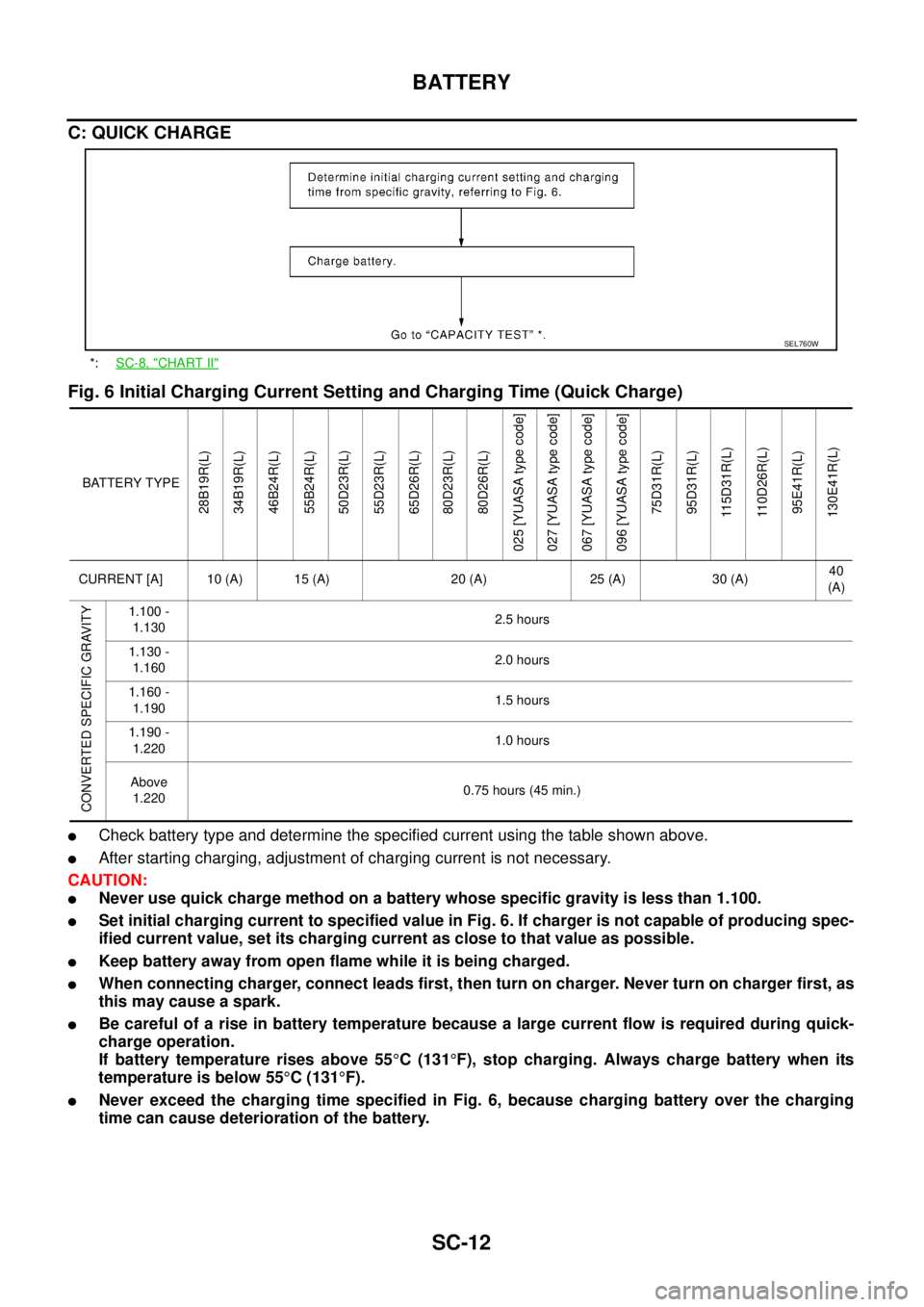Page 3230 of 3502

SC-12
BATTERY
C: QUICK CHARGE
Fig. 6 Initial Charging Current Setting and Charging Time (Quick Charge)
�Check battery type and determine the specified current using the table shown above.
�After starting charging, adjustment of charging current is not necessary.
CAUTION:
�Never use quick charge method on a battery whose specific gravity is less than 1.100.
�Set initial charging current to specified value in Fig. 6. If charger is not capable of producing spec-
ified current value, set its charging current as close to that value as possible.
�Keep battery away from open flame while it is being charged.
�When connecting charger, connect leads first, then turn on charger. Never turn on charger first, as
this may cause a spark.
�Be careful of a rise in battery temperature because a large current flow is required during quick-
charge operation.
If battery temperature rises above 55°C (131°F), stop charging. Always charge battery when its
temperature is below 55°C (131°F).
�Never exceed the charging time specified in Fig. 6, because charging battery over the charging
time can cause deterioration of the battery.
*:SC-8, "CHART II"
SEL760W
BATTERY TYPE
28B19R(L)
34B19R(L)
46B24R(L)
55B24R(L)
50D23R(L)
55D23R(L)
65D26R(L)
80D23R(L)
80D26R(L)
025 [YUASA type code]
027 [YUASA type code]
067 [YUASA type code]
096 [YUASA type code]
75D31R(L)
95D31R(L)
115D31R(L)
110D26R(L)
95E41R(L)
130E41R(L)
CURRENT [A] 10 (A) 15 (A) 20 (A) 25 (A) 30 (A)40
(A)
CONVERTED SPECIFIC GRAVITY
1.100 -
1.1302.5 hours
1.130 -
1.1602.0 hours
1.160 -
1.1901.5 hours
1.190 -
1.2201.0 hours
Above
1.2200.75 hours (45 min.)
Page 3238 of 3502
SC-20
STARTING SYSTEM
Disassembly and Assembly BKS0027C
DISASSEMBLY
VQ23DE MODELS
PKIA3568E
1. Magnetic switch assembly 2. Adjusting plate 3. Packing
4. Metal FR 5. Plate 6. Shift lever
7. Gear case 8. Yoke 9. Armature
10. Brush holder assembly 11. Metal RR 12. Rear cover
13. Through-bolt 14. Packing 15. Ball
16. Planetary gear 17. Gear shaft 18. Internal gear
19. Pinion assembly 20. Stopper 21. Stopper ring
Page 3239 of 3502
STARTING SYSTEM
SC-21
C
D
E
F
G
H
I
J
L
MA
B
SC
VQ35DE MODELS
SKIB6768E
1. Magnetic switch assembly 2. Plate 3. Packing
4. Plate 5. Shift lever 6. Front bracket assembly
7. Pinion spring 8. Pinion assembly 9. Pinion stopper
10. Stopper ring 11. Brush holder assembly 12. Metal
13. Rear cover 14. Through-bolt 15. Armature assembly
16. Yoke assembly 17. Packing 18. Ball
19. Gear assembly 20. Gear shaft 21. Internal gear assembly
22. Clutch gear assembly
: N·m (kg-m, in-lb)
(H): High-temperature grease point
Page 3240 of 3502
SC-22
STARTING SYSTEM
QR20DE MODELS
PKIA4810E
1. Magnetic switch assembly 2. Dust cover kit 3. Shift lever set
4. Gear case assembly 5. Center bracket (A) 6. Yoke
7. Armature 8. Brush holder assembly 9. Thrust washer
10. Rear cover assembly 11. Through-bolt 12. Internal gear
13. Planetary gear 14. Packing 15. Thrust washer
16. Center bracket (P) 17. E-ring 18. Pinion shaft
19. Pinion spring 20. Pinion 21. Pinion stopper
22. Pinion stopper clip
Page 3244 of 3502
SC-26
STARTING SYSTEM
ASSEMBLY
Apply high-temperature grease to lubricate the bearing, gears and frictional surface when assembling the
starter.
Carefully observe the following instructions.
Pinion Protrusion Length Adjustment
CLEARANCE (VQ23DE AND VQ35DE MODELS)
�With pinion driven out by magnetic switch, push pinion back to
remove slack and measure clearance “L” between the front
edge of the pinion and the pinion stopper.
�Not in the specified value... Adjust by adjusting plate.
MOVEMENT (QR20DE MODELS)
�Compare movement “L” in height of pinion when it is pushed out
with magnetic switch energized and when it is pulled out by
hand until it touches stopper.
�Not in the specified value... Adjust by adjusting plate.Clearance “L” : Refer to SDS. SC-38, "
Starter" .
SKIB0229E
SEL633BA
Movement “L” : Refer to SDS. SC-38, "Starter" .
SKIB0230E
SEL633BA
Page 3256 of 3502

SC-38
SERVICE DATA AND SPECIFICATIONS (SDS)
SERVICE DATA AND SPECIFICATIONS (SDS)PFP:00030
BatteryBKS001MO
StarterBKS0027G
AlternatorBKS0027H
Applied modelStandard
Ty p e80D23L
Capacity12V -52AH
Applied model VQ23DE VQ35DE QR20DE
Ty p eM0T87181 M1T68681 S114 - 844
MITSUBISHI make HITACHI make
Reduction gear type
System voltage12 V
No-loadTerminal voltage 11 V
Current Less than 90 A
Revolution More than 2,800 rpm More than 2,750 rpm More than 2,700 rpm
Minimum diameter of commutator 28.8 mm (1.134 in) 28.0 mm (1.102 in)
Minimum length of brush 7.0 mm (0.276 in) 10.5 mm (0.413 in)
Brush spring tension18.3 - 24.8 N
(1.87 - 2.53 kg, 4.12 -
5.58 lb)15.0 - 20.4 N
(1.53 - 2.08 kg, 3.3 -
1.5 lb)16.2 N
(1.65 kg, 3.64 lb)
Clearance between bearing metal and armature shaft Less than 0.2 mm (0.008 in)
Clearance “L” between pinion front edge and pinion stopper0.5 - 2.0 mm (0.020 -
0.079 in)––
Movement “L” in height of pinion assembly –0.5 - 2.0 mm (0.020 -
0.079 in)0.3 - 2.5 mm (0.012 -
0.098 in)
Applied model VQ23DE, VQ35DE QR20DE
TypeLR1110 - 723E LR1110 - 713B
HITACHI make
Nominal rating12 V - 110 A
Ground polarityNegative
Minimum revolution under no-load (When 13.5 V is applied) Less than 1,100 rpm
Hot output current (When 13.5 V is applied)(More than 35 A/1,300 rpm)
More than 70 A/1,800 rpm
More than 91 A/2,500 rpm
More than 110 A/5,000 rpm
Regulated output voltage 14.1 - 14.7 V
Minimum length of brush More than 6.00 mm (0.236 in)
Brush spring pressure 1.00 - 3.43 N (102 - 350 g, 3.60 - 12.34 oz)
Slip ring minimum outer diameter More than 26.0 mm (1.024 in)
Rotor (Field coil) resistance 2.16 - 2.46 Ω
Page 3264 of 3502

SE-8
SQUEAK AND RATTLE TROUBLE DIAGNOSES
FELT CLOTHTAPE
Used to insulate where movement does not occur. Ideal for instrument panel applications.
68370-4B000: 15 × 25 mm (0.59 × 0.98 in) pad/68239-13E00: 5 mm (0.20 in) wide tape roll
The following materials, not available through NISSAN Parts Department, can also be used to repair squeaks
and rattles.
UHMW(TEFLON) TAPE
Insulates where slight movement is present. Ideal for instrument panel applications.
SILICONE GREASE
Used in place of UHMW tape that will be visible or not fit.
Note: Will only last a few months.
SILICONE SPRAY
Use when grease cannot be applied.
DUCT TAPE
Use to eliminate movement.
CONFIRM THE REPAIR
Confirm that the cause of a noise is repaired by test driving the vehicle. Operate the vehicle under the same
conditions as when the noise originally occurred. Refer to the notes on the Diagnostic Worksheet.
Generic Squeak and Rattle TroubleshootingBIS001TO
Refer to Table of Contents for specific component removal and installation information.
INSTRUMENT PANEL
Most incidents are caused by contact and movement between:
1. Cluster lid A and instrument panel
2. Acrylic lens and combination meter housing
3. Instrument panel to front pillar garnish
4. Instrument panel to windshield
5. Instrument panel mounting pins
6. Wiring harnesses behind the combination meter
7. A/C defroster duct and duct joint
These incidents can usually be located by tapping or moving the components to duplicate the noise or by
pressing on the components while driving to stop the noise. Most of these incidents can be repaired by apply-
ing felt cloth tape or silicon spray (in hard to reach areas). Urethane pads can be used to insulate wiring har-
ness.
CAUTION:
Do not use silicone spray to isolate a squeak or rattle. If you saturate the area with silicone, you will
not be able to recheck the repair.
CENTER CONSOLE
Components to pay attention to include:
1. Shifter assembly cover to finisher
2. A/C control unit and cluster lid C
3. Wiring harnesses behind audio and A/C control unit
The instrument panel repair and isolation procedures also apply to the center console.
DOORS
Pay attention to the:
1. Finisher and inner panel making a slapping noise
2. Inside handle escutcheon to door finisher
3. Wiring harnesses tapping
4. Door striker out of alignment causing a popping noise on starts and stops
Tapping or moving the components or pressing on them while driving to duplicate the conditions can isolate
many of these incidents. You can usually insulate the areas with felt cloth tape or insulator foam blocks to
repair the noise.
Page 3268 of 3502

SE-12
AUTOMATIC DRIVE POSITIONER
AUTOMATIC DRIVE POSITIONERPFP:28491
System Description BIS0012G
�The system automatically moves the driver seat to facilitate entry/exit to/from the vehicle. The automatic
drive positioner control unit can also store the optimum driving positions (driver seat) for 2 people. If the
driver is changes, one-touch operation allows changing to the other driving position.
�Using CONSULT-II, the seat slide amount at entry/exit setting can be changed.
MANUAL OPERATION
The driving position (seat position) can be adjusted with the power seat switch.
NOTE:
The seat can be manually operated with the ignition switch OFF.
A U T O M AT I C O P E R AT I O N
NOTE:
�Disconnecting the battery erases the stored memory.
�After connecting the battery, insert the key into the ignition cylinder and turn the driver door switch ON (open)→OFF (close)→ON
(open), the Entry/ Exiting operation becomes possible.
�After exiting operation is carried out, entry operation can be operated.
NOTE:
During automatic operation, if the ignition switch is turned ON→START, the automatic operation is suspended. When the ignition switch
returns to ON, it resumes.Function Description
Memory switch operation The seat move to the stored driving position by pushing memory switch (1 or 2).
Entry/Exiting functionExiting operation At exit, the seat moves backward.
Entry operation At entry, the seat returns from the exiting position to the previous driving position.
Keyfob interlock operation Perform memory operation and exiting operation by pressing keyfob unlock button.
Auto operation temporary stop
conditions.When ignition switch turned to START during memory switch operation and return opera-
tion, memory switch operation and entry operation is stopped.
Auto operation stop conditions.
�When the vehicle speed becomes 7 km/h (4 MPH) or higher.
�When the setting switch, memory switch 1, or 2 are pressed.
�When A/T or CVT selector lever is in any position other than P.
�When power seat switch turned ON.
�When driver seat sliding Entry/Exiting setting is OFF (only entry/exiting operation).